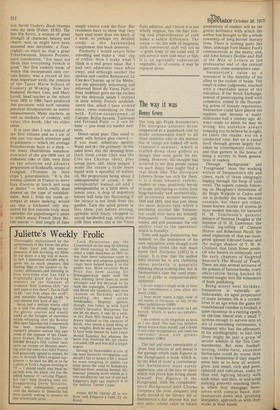The Good Life
Bulldog reading
Pamela Vandyke Price
The soft underbelly of the French gastronomic press would appear to have received a nipping from the recent feature in the Times by the colleague variously referred to — in France — as Egon Rooney, and, among the irreverent here, as Vladimir Gestetner. The frogs don't like this criticism of their classier noshbars.
1, fresh from that fair country which we should never have let go, will hurl a — figurative — dumpling of the ilk that the snaileaters pretend to confuse with cannonballs, right into the bouillon and avow that certain of my experiences in the French provinces have been gastronomic Guignol of a grand type. Of course I had some good meals And of course I encountered some revelations as to what food can be. But whereas in Britain one .prudently expects to eat ill and therefore receives certain pleasant surprises, in France one does anticipate being able to wrap onself round the majority of meals with the avidity of a boa constrictor cranking itself up for the goat-ingurgitating stakes.
What about the starred restaurant wherein I endured mushrooms at every course (they might have entered the pud but I eschewed same)? The ditto where the hors d'oeuvre comprised six dishes, four of these with glutinous sauces, the fish came awash with a glutinous sauce, and the guinea-fowl — you've guessed it? What about the flesh and fowl from which my knife staggered ineffectually away, the ice-creams from some mass purveyor served minus even the most papery wafer, the salads sharp with vinegar and meagrely dressed with medicinal oil, and the absence, again and again, of anything crisp to set off the blanditude of the dish, piquant to balance the suavity of so many cream sauces and, most of all, green to redress the dominating beige hue? This to me is not eating well. Often it meant that I did not eat at all.
Back in the metropolis, The New Iris Syrett Cookery Book thumps onto my desk (Faber, £4.95). The late Iris Syrett, a woman of great strength of character, beauty and charm, was, as might have been assumed was inevitable, a Francophile, so much so, that a great Frenchwoman, Simone Prunier, once commented, "Iris must not think that everything French is good." Her first cookery book, of which this incorporates only certain basics, was a record of her most important work, the creation of the Tante Marie School of Cookery at Woking. Now her husband, Herbert Lees, and Mary Lovell, head teacher at the school from 1956 to 1960, have produced this successor, with such valuable practical incorporations as metric measurements. Many teachers, as well as students of cookery, will value this book, like its elder sister.
It is true that I was critical of the first volume and so I am of this one: too much attention paid to patisserie — which the average Frenchwoman buys at a shop — too many illustrations somehow evocative of the pre-1939 sort of elaborate cake or dish, very little on the selection and advance preparation of foodstuffs, scraps of Franglais ('Pommes de terre chips '), generalisation. "It is the normal custom in France to serve hors d'oeuvre at lunch and soup at dinner" — which really does depend on the type of establishment. And I, from my meek attempts at sauce making, would say That a bdchamel only simmered for five minutes truly must resemble the paperhanger's paste to which many French liken British sauces — that length of time simply cannot cook the flour. But reviewers have to show that they have read more than the blurb of a book, so perhaps my detailed study is the backhanded compliment this book deserves.
Formerly I would return from travelling and make a ' real ' cup of coffee. Now I make what I think is a real green salad. But I had two admirable ones while away, and although neither the serious and careful Restaurant La Cles des Champs, up in the Medoc, nor the admirably welcoming and informed Hotel du Vieux Puits at Pont AudOmer gave me the recipes for the delicious salads I enjoyed in their wholly French establishments this, which I have evolved since, owes something to them both. Fellow-countrymen of Careme, Brillat-Savarin, Taillevent and Fernand Point — it can be done — you must try harder next term.
Green salad plus: This salad is made with lettuce plus chervil — if you must, substitute parsley. Wash and dry the greenery. In the salad bowl, mix the dressing from thick fresh cream (this was the Cles des Champs idea), plus lemon juice, salt, black pepper. I made' the cream a little more liquid with a spoonful of walnut oil, the proportions being about 2 tablespoonsful of cream, 1 dessertspoonful walnut oil and 1 tablespoonsful or a little more of lemon juice. A drop of angostura bitters will help the flavouring if the lettuce is not fresh from the garden. Turn the salad greens in this, then, just before serving, sprinkle with finely chopped or sieved hardboiled egg, using more yolk than white; this is the Vieux
Puits addition, and I know it is not wholly original, but the fine sieving and preponderance of yolk make a subtle difference. The cream — no, the milk of magnesia style commercial stuff will not do — gives body to the salad and, if you serve it with cold meat or fish, it is an agreeably substantial vegetable, or, of course, it may be enjoyed alone.



































































 Previous page
Previous page